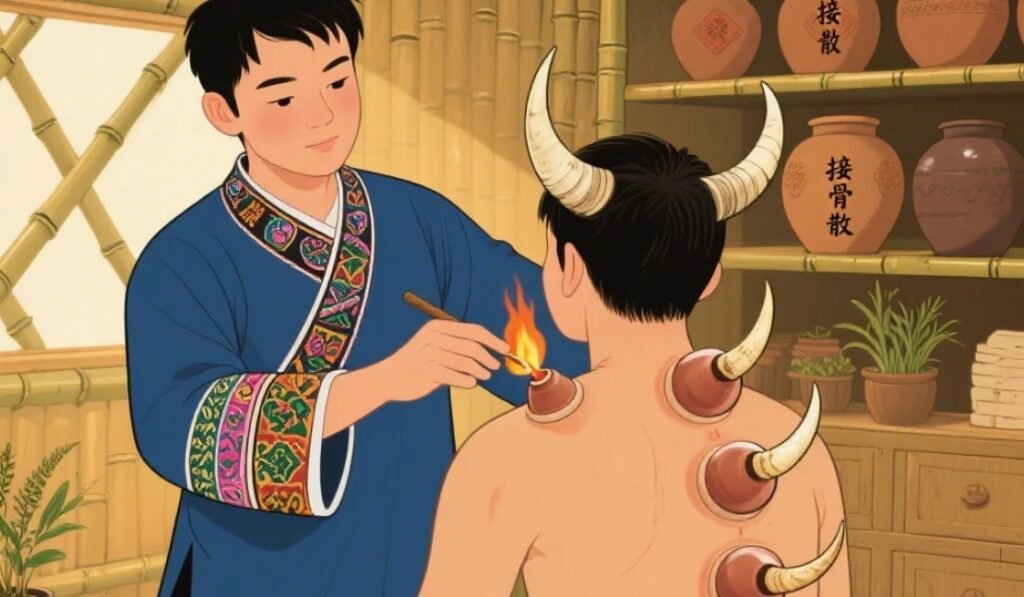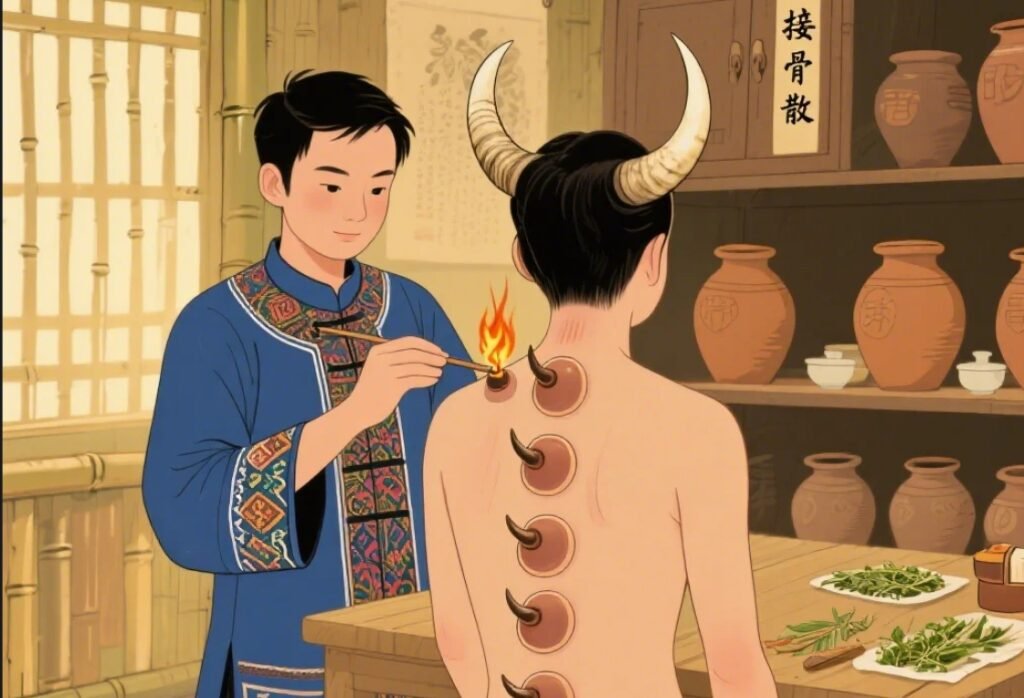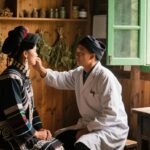Fenglepu·Lana (Pulmonary Consumption)
Overview
In Miao medicine, pulmonary consumption is called Fenglepu·Lana, which includes Songruipao Puwu and Gaojia. Songruipao Puwu refers to pulmonary tuberculosis caused by chronic depletion of the lungs; Gaojia refers to a contagious lung disease. This chapter focuses on Gaojia.
In Traditional Chinese Medicine (TCM), pulmonary consumption is a chronic wasting disease caused by deficiency of vital qi and infection by lao chong (tuberculosis pathogen). Its main clinical manifestations are cough, hemoptysis (coughing blood), tidal fever, night sweats, and emaciation.
In Western medicine, conditions such as pulmonary tuberculosis and tuberculous pleurisy, which present with cough, hemoptysis, tidal fever, and night sweats, can be diagnosed and treated with reference to this disease.
Houkoudipeng·Miao Medicine Symptoms
Fenglepu·Lana is a major disease and is categorized into three subtypes: pulmonary consumption due to qi and blood deficiency, blood deficiency pulmonary consumption, and pulmonary and kidney deficiency pulmonary consumption.
Aijiangduo·Causes
This disease results from deficiency of qi and blood in the body, which allows pathogenic toxins to invade and weaken the vital energy. Miao medicine distinguishes Gaojia and Songruipao Puwu as two different conditions: Gaojia is infectious, while Songruipao Puwu is non-infectious.
Gengduomeng·Pathogenesis
When vital qi is depleted, chronic damage to the lungs results in Songruipao Puwu. If external toxins invade and attack the lungs, the condition may become contagious, resulting in Gaojia. The primary location of the disease is the lungs. Over time, it may involve the spleen and kidneys, accompanied by signs of qi and blood deficiency.
Key Diagnostic Points
Diagnostic Criteria
(1) Main symptoms include chronic cough, hemoptysis, tidal fever, night sweats, and weight loss.
(2) History of prolonged contact with pulmonary tuberculosis patients.
(3) Exclusion of cough from other internal medicine diseases.
Relevant Examinations
Chest X-rays, sputum smears, and sputum cultures can aid diagnosis.

Differential Diagnosis
Jiangbinwo (Wasting Syndrome)
Both Jiangbinwo and pulmonary consumption involve deficiency conditions. However, they differ in disease location, nature, course, and severity. Wasting syndrome involves multiple organ systems with combined deficiency of qi, blood, yin, and yang, primarily affecting the spleen and kidneys. The pathogenesis emphasizes overall depletion. Pulmonary consumption is mainly due to qi deficiency and pulmonary damage caused by tuberculosis pathogens, and its pathogenesis is characterized by yin deficiency. Main symptoms include cough, hemoptysis, tidal fever, and night sweats.
Syndrome Classification and Treatment
1. Xiangxiu Gaojia (Pulmonary Consumption due to Blood Deficiency)
Symptoms: Fatigue, afternoon fever, flushed cheeks, dry cough with scanty or blood-streaked sputum, loss of appetite, emaciation.
Cold or Hot Syndrome: Cold pattern.
Treatment Principle: Activate blood and moisten lungs (Weixiangyang Renfunaibo).
Prescription and Explanation:
Mai dong (Ophiopogon root, maidong) 20g
Tian dong (Asparagus root, tiandong) 20g
Sha shen (Glehnia root, shashen) 30g
Bai bu (Stemona root, baibu) 20g
Xue ren shen (Pseudostellaria root, xue renshen) 15g
Pipa ye (Loquat leaf, pipaye) 20g
Decoction for oral administration.
Explanation:
Mai dong, warm and sweet, enters cold channels, nourishes yin and generates fluids.
Tian dong, warm and sweet, moistens dryness and clears heat.
Sha shen, warm and sweet, nourishes yin, moistens lungs, and stops cough.
Bai bu, cold and bitter, enters hot channels, descends qi, eliminates phlegm, and kills parasites.
Xue ren shen, warm, astringent, slightly bitter, tonifies qi, nourishes yin and blood.
Pipa ye, cold and bitter, clears heat, supports lungs, activates blood, and unblocks collaterals.
2. Ben Xiangxiu Gaojia (Pulmonary Consumption due to Qi and Blood Deficiency)
Symptoms: Cough, post-meal fever, pale complexion, emaciation, eyelid edema, shortness of breath with weak voice, poor appetite, loose stools.
Cold or Hot Syndrome: Cold pattern.
Treatment Principle: Tonify qi (Buben), strengthen spleen (Maijian Maiweinei), stop cough (Dangou).
Prescription and Explanation:
Pao shen (American ginseng, paoshen) 30g
Shan yao (Chinese yam, shanyao) 20g
Bai shao (White peony root, baishao) 12g
Bai he (Lily bulb, baihe) 30g
Fu ling (Poria, fuling) 20g
Dang gui (Chinese angelica, danggui) 15g
Decoction for oral administration.
Explanation:
Pao shen, slightly cold, sweet and slightly bitter, tonifies qi and blood.
Shan yao, cold and sweet, strengthens spleen and dispels dampness.
Bai shao, cold and bitter, nourishes blood and supports qi.
Bai he, warm and sweet, moistens lungs and stops cough.
Fu ling, warm and sweet, drains dampness.
Dang gui, warm, sweet and acrid, tonifies and moves blood.

3. Fenglepu Amaiwu·Naidiu Amaiou Gaojia (Pulmonary and Kidney Deficiency Syndrome)
Symptoms: Afternoon fever, flushed face, dry cough (sometimes with blood), heat in palms and soles, insomnia, night sweats, chest pain, hoarse voice.
Cold or Hot Syndrome: Cold pattern.
Treatment Principle: Activate blood and moisten lungs (Weixiangyang Renfunaibo), clear fire and stop bleeding (Baidu Dangxiang).
Prescription and Explanation:
Shida gonglao (Mahonia, shidagonglao) 20g
Bazhao jinlong (Fissistigma oldhamii, bazhaojinlong) 15g
Sha shen (Glehnia root, shashen) 30g
Bai he (Lily bulb, baihe) 30g
Wu wei zi (Schisandra, wuweizi) 15g
Huer cao (Saxifraga, huercao) 20g
Decoction for oral administration.
Explanation:
Shida gonglao, cold and bitter, clears heat, expels pathogens, and kills parasites.
Bazhao jinlong, cold and bitter, clears heat and soothes the throat.
Sha shen, warm and sweet, nourishes yin, moistens the lungs, stops cough.
Bai he, warm and sweet, moistens lungs and stops cough.
Wu wei zi, cold and bitter, astringes the lungs and stops cough.
Huer cao, warm and sweet, expels wind-heat and cools blood.
Preventive Care
Avoid contact with tuberculosis patients and infectious sources.
Prevent exposure to cold; stay warm appropriately.
Abstain from smoking and alcohol; maintain a nourishing, easily digestible diet that does not harm the spleen and stomach.
Live with proper balance of work and rest; maintain a regular daily schedule and moderate sexual activity.
Manage emotions and avoid excessive worry.
Commentary
In Miao medicine, the causes of disease are primarily categorized as internal damage and external factors. According to The Common Origin of All Things, Soumei ruo (energy), Gebogang sou (substance), and Maru wucui (structure) are the three fundamental elements of all things, and none can be dispensed with. Water, qi, and blood are the basic substances of the human body. They are interdependent and influence each other. Qi drives blood circulation—”qi and blood depend on each other; qi propels blood, blood carries qi.” Water generates blood, and blood carries water—”blood cannot form without water, and water cannot nourish without blood.”
This disease arises from different causes of qi and blood deficiency, and invasion of pathogenic toxins leads to weakness and disease. Treatment is primarily based on tonifying deficiency, supplemented by replenishing qi, strengthening the spleen, enriching the blood, nourishing yin, moistening the lungs, and relieving cough.


Leave a Reply